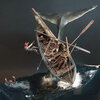- Joined
- Sep 4, 2022
- Messages
- 1,291
I'm not a diorama guy, but do have experience in museum exhibitry and visual design.
On another thread, it occurred to me that controlling the viewer's point of view might offer interesting possibilities, whether literally 'staging' a dio in an enclosure to direct the viewer to a specific line of sight, or mounting the dio on a turntable with a clock motor to rotate it through a particular axis...
...it was a comment from... drat, now I can't find it again, anyhow, basically describing our efforts as "static" that got me thinking, why not explore techniques from exhibitry, photography and film?
Think: the opening scenes of Apocalypse Now, where the camera pulls us in, upside down, with the ceiling fan blades cutting across the screen.
It is disorienting, but adds a whole new dimension to a scene with a guy just lying there, "static".
Cheers!
On another thread, it occurred to me that controlling the viewer's point of view might offer interesting possibilities, whether literally 'staging' a dio in an enclosure to direct the viewer to a specific line of sight, or mounting the dio on a turntable with a clock motor to rotate it through a particular axis...
...it was a comment from... drat, now I can't find it again, anyhow, basically describing our efforts as "static" that got me thinking, why not explore techniques from exhibitry, photography and film?
Think: the opening scenes of Apocalypse Now, where the camera pulls us in, upside down, with the ceiling fan blades cutting across the screen.
It is disorienting, but adds a whole new dimension to a scene with a guy just lying there, "static".
Cheers!

